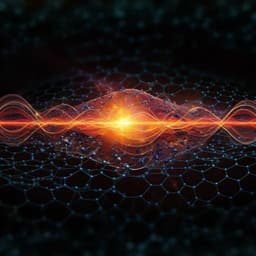
Physics
Giant nonlinear Hall effect in twisted bilayer WTe₂
Z. He and H. Weng
This groundbreaking research showcases a giant nonlinear Hall effect in twisted bilayer WTe₂, highlighting an unprecedented Berry curvature dipole and tunable nonlinear Hall signals. Conducted by Zhihai He and Hongming Weng, this work positions twisted bilayer WTe₂ as a prime candidate for exploring the nonlinear Hall effect.
~3 min • Beginner • English
Introduction
The study of Hall and anomalous Hall effects typically requires breaking time-reversal symmetry via magnetic fields or magnetic ordering. Recent theory predicts, however, that a second-order nonlinear Hall effect can arise in time-reversal-invariant but inversion-symmetry-broken systems, governed by a nonzero Berry curvature dipole. Experiments in bilayer and multilayer WTe₂ have validated such nonlinear Hall-like currents. Given that twist angle in 2D bilayers is a powerful knob to engineer electronic structures—as evidenced by correlated and superconducting phases in twisted bilayer graphene and TMDs—the authors ask how twisting modulates the nonlinear Hall effect in bilayer WTe₂. Using first-principles and semiclassical theory, they construct twisted bilayer WTe₂ across a wide range of twist angles (12°–73°) and identify that at θ = 29.4° the Berry curvature dipole and resulting nonlinear Hall response are strongly enhanced and highly tunable.
Literature Review
Theory by Sodemann and Fu established the nonlinear Hall effect from Berry curvature dipoles in time-reversal-symmetric systems. Experiments subsequently observed nonlinear Hall responses in few-layer WTe₂. Numerous materials have been predicted or shown to host strong nonlinear Hall effects, including Weyl semimetals, BiTeI under pressure, monolayer WTe₂ and MoTe₂ under external electric fields, and strained twisted bilayer graphene and WSe₂. Nonlinear Hall observations have been largely in 2D systems. Twist angle emerges as a key control parameter in 2D bilayers, with recent reports of large nonlinear Hall responses in strained twisted bilayer graphene and WSe₂. These works motivate examining twisted bilayer WTe₂ as a potentially tunable and strong nonlinear Hall platform.
Methodology
Twisted bilayer construction: Starting from an orthorhombic bilayer WTe₂ with optimized primitive lattice constants a₁ = 3.447 Å and a₂ = 6.284 Å, commensurate twisted supercells are generated by superlattice vectors b₁ = m a₁ + n a₂ and b₂ = p a₁ + q a₂ (m, n, p, q integers), with the top layer rotated by θ = 2 arctan(m|a₁|/(n|a₂|)) and translated by b₂ relative to a fixed bottom layer. Approximate orthogonality of b₁ ⟂ b₂ within 89°–91° is enforced to achieve near-commensurability. Structures are fully relaxed; interlayer spacing is corrugated and slightly larger than perfect bilayer.
Nonlinear Hall formalism: With time-reversal symmetry but broken inversion, under an oscillating electric field E_c = Re{E_c e^{iωt}}, the current response j_a = Re{χ^{(1)}_{abc} E_c + χ^{(2)}_{abcd} E_c E_d} includes a second-order contribution governed by the Berry curvature dipole D_{bd}. The intrinsic nonlinear conductivity tensor is χ_{abc} = ε_{adc} e^3 τ /(2 ħ^2 (1 + i ω τ)) D_{bd}. The Berry curvature dipole is computed from band structure as D_{bd} = Σ_n ∫ f_{nk} ∂_{k_b} Ω_{nk,d} d^2k, where for 2D systems only Ω_{nk,z} is nonzero. The Berry curvature is evaluated from interband matrix elements Ω_{nk,z} = 2 Σ_{m≠n} Im[⟨n|∂_{k_x}|m⟩⟨m|∂_{k_y}|n⟩ − (x↔y)]/(E_n − E_m)^2.
First-principles calculations: Density functional theory is performed with VASP using PAW potentials and the PBE GGA exchange-correlation functional. Spin–orbit coupling is included self-consistently. Plane-wave cutoff is 350 eV. A vacuum thickness >15 Å prevents inter-slab interactions. Structures are relaxed until forces <0.02 eV/Å. Interlayer van der Waals interactions are treated with Grimme’s DFT-D3 (zero damping). Maximally localized Wannier functions (W d and Te p orbitals) are constructed to compute Ω(k) and D. The Brillouin zone is sampled with extremely dense k-grids; to manage computational cost the zone is partitioned into blocks with independent convergence tests, reaching k-point separations as fine as 5 × 10⁻⁵ Å⁻¹ in some blocks.
Systems studied: Multiple commensurate twist angles from ~12° to ~73° are constructed. A representative system with θ = 29.4° (smallest supercell) is analyzed in detail; θ = 40.1° is also evaluated for angle dependence. Formation energies and average interlayer distances are tabulated across twists.
Key Findings
- Twisted bilayer WTe₂ exhibits complex Moiré superlattices and intricate electronic structures with abundant band anticrossings and inversions near the Fermi level; with SOC the entanglement is enhanced.
- For θ = 29.4°, the Berry curvature dipole shows giant peaks and strong, rapid sign oscillations within a narrow energy window around EF. The peak D_xz reaches ~1400 Å near EF, far exceeding prior reports (e.g., ~10 Å in mono/bilayer WTe₂, 25 Å in strained twisted WSe₂, ~200 Å in strained twisted bilayer graphene, ~700 Å in corrugated bilayer graphene).
- Both D_xz and D_yz become nonzero in the twisted system due to symmetry breaking (M_z broken by twist), unlike perfect bilayer WTe₂ where only D_y is allowed.
- The large Berry curvature dipole originates from sharp variations of Ω_z near band edges created by multiple near-crossings; specific contributions are traced to band-edge features at approximately −0.02, −0.01, 0.0, and 0.02 eV relative to EF.
- Temperature dependence at charge neutrality: D_yz in twisted bilayer (θ = 29.4°) exceeds that of perfect bilayer at low temperatures; it grows rapidly below ~20 K, indicating strong low-T nonlinear Hall response, while at higher T (>20 K) it is only slightly larger than perfect bilayer.
- Angle dependence: For θ = 40.1°, the Berry curvature dipole also attains very large magnitude (>1500 Å) with similarly drastic oscillations, suggesting that other moderate-angle twists may host giant, highly tunable nonlinear Hall signals.
- Structural energetics: Across twist angles 12.3°–72.3°, formation energies are similar (ΔE ≈ 6.37–6.83 meV/Ų) and average interlayer distances slightly exceed that of perfect bilayer (e.g., 3.284 Å at 29.4° vs 2.888 Å in perfect), implying weakened interlayer coupling and feasible formation of twisted structures.
Discussion
The study demonstrates that twisting bilayer WTe₂ profoundly modifies band topology near EF, producing dense anticrossings that generate large Berry curvature variations and thus a giant Berry curvature dipole. This directly addresses the question of whether twist can enhance and tune the nonlinear Hall effect: both magnitude and sign of the response can be sharply modulated by small shifts of EF, while the overall scale surpasses known systems by an order of magnitude or more. The strong low-temperature enhancement (rapid rise of D_yz below ~20 K) suggests experimental observability in cryogenic regimes. Angle dependence analysis (θ = 40.1°) confirms generality of the mechanism for moderate angles; band structures at θ = 12.3° and 25.7° also contain rich crossings, implying similar oscillatory nonlinear Hall behavior. Compared to the smoother response of perfect bilayer, twist-induced band entanglement is key to the giant effect. While this work focuses on the intrinsic (geometric) contribution tied to the Berry curvature dipole, prior theory indicates that extrinsic, disorder-induced mechanisms can dominate in some cases. In twisted bilayers, twist-angle nonuniformity is a likely disorder source that could significantly influence the net nonlinear Hall effect. Thus, both intrinsic band-structure design via twist and extrinsic sample quality will determine experimental responses.
Conclusion
Twisted bilayer WTe₂ is predicted to host a giant, highly tunable nonlinear Hall effect. At θ = 29.4°, the Berry curvature dipole peaks around ~1400 Å with pronounced oscillations and sign reversals near EF, vastly exceeding previously reported systems. Similar or larger magnitudes are found at θ = 40.1°, indicating that moderate-angle twists generally produce strong responses due to abundant band anticrossings/inversions. The effect is especially strong at low temperatures and is sensitive to Fermi-level tuning, making twisted bilayer WTe₂ an excellent platform to study and control nonlinear Hall physics. Future research should map the full angle dependence (including small angles), incorporate extrinsic disorder contributions quantitatively, and refine electronic structure with beyond-PBE methods to address small gaps observed experimentally.
Limitations
- Electronic structure calculations use PBE-GGA, which may underestimate band gaps; experiments report small gaps at certain twist angles not captured here.
- Only a subset of twist angles is computed for nonlinear responses due to high computational cost; conclusions for other angles (especially very small angles) are extrapolated from band-structure features and may not hold.
- The study focuses on the intrinsic (Berry curvature dipole) contribution; extrinsic disorder-induced contributions, which can be significant, are not quantified. Real devices may exhibit twist-angle nonuniformity that alters the response.
- Strongest predicted signals occur at low temperatures (<20 K), potentially limiting room-temperature applicability.
- Approximations in constructing commensurate supercells (near-orthogonality of superlattice vectors) may introduce small deviations from ideal twist conditions.
Related Publications
Explore these studies to deepen your understanding of the subject.







